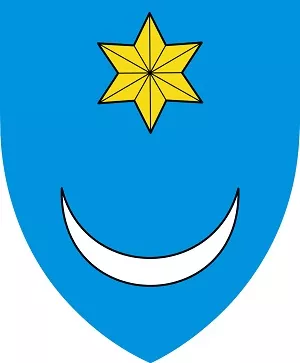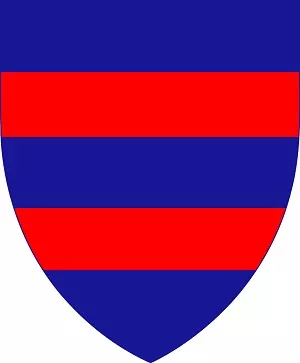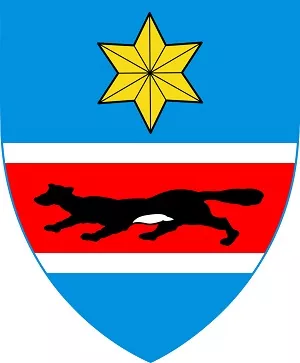Unveiling Croatia's Pride: The Complete Guide to the Croatia Flag
The Croatia Flag, adopted on December 22, 1990, is a testament to the nation's heritage and identity. Comprising three equal horizontal stripes of red, white, and blue, it symbolizes unity. Embellished with a unique "crown," featuring five shields from Croatia's history, the flag replaced its predecessor, the red-starred emblem, in 1990. It stands proudly as a cherished symbol of Croatia's past and present.
Table of Contents
Hide

Nightstallion, Elephantus, Neoneo13, Denelson83, Rainman, R-41, Minestrone, Lupo, Zscout370,MaGa (based on Decision of the Parliament), Public domain, via Wikimedia Commons
Description of the Croatia Flag
Ever pondered, "What does the Croatia flag look like?" Take a glance above. It's a striking emblem steeped in history and meaning. Comprising three equal horizontal stripes in red, white, and blue, it embodies Croatia's identity. Nestled in the middle is the Coat of Arms of Croatia, adding depth to its symbolism. The flag's design seamlessly merges the colors of the Kingdoms of Croatia, Slavonia, and Dalmatia, reflecting its rich heritage. Since 1848, this red-white-blue tricolour has been a beacon of Croatian pride, resonating with romantic nationalism. Over time, its design has evolved, shedding symbols like the "U" and the five-pointed star for the modern crown and coat of arms. The shield, adorned with the iconic red and white checkerboard, stands proudly atop the flag, representing Croatia's unity and diversity.

Flag of the Independent State of Croatia (1941–1945) - public domain by User:Zscout370, Public domain, via Wikimedia Commons
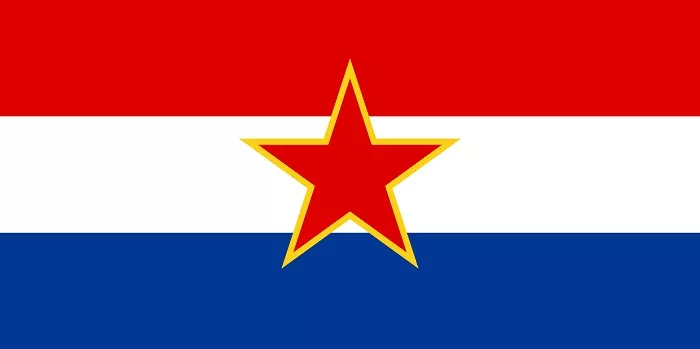
Flag of the Socialist Republic of Croatia (18 January 1947 – 25 July 1990) - Zscout370, Public domain, via Wikimedia Commons
Coat of Arms of Croatia - The Shield on the Croatian Flag
The coat of arms of the Republic of Croatia, known as Grb Republike Hrvatske in Croatian, comprises a primary shield accompanied by five smaller shields arranged in a crown-like fashion above it. The main emblem features a checkered pattern consisting of 13 red and 12 white fields, commonly referred to as šahovnica ("chessboard" in Croatian, derived from šah, meaning "chess"). The five smaller shields symbolize distinct historical regions within Croatia.
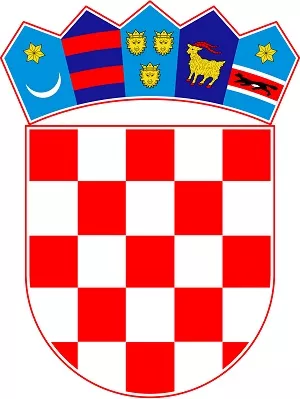
Croatian Parliament - ZAKON O GRBU, ZASTAVI I HIMNI RH TE ZASTAVI I LENTI PREDSJEDNIKA RH which based its decision on the design by Miroslav Šutej F.C.A. proposals.Ma (based on Decision of the Parliament), Public domain, via Wikimedia Commons
On December 21, 1990, the Croatian government, transitioning from socialism, approved a legislation endorsing the design crafted by the painter and graphic artist Miroslav Šutej. This design was developed under the guidance of a committee led by Nikša Stančić, who was serving as the head of the Department of Croatian History at the Faculty of Philosophy, University of Zagreb.
The revised design introduced five additional crowning shields, each representing distinct regions of Croatia. These shields, arranged from left to right, are:
Oldest known symbol representing Croatia
Considered as the earliest symbol representing Croatia, Bleu celeste depicts a six-pointed mullet Or positioned atop a crescent Argent. This emblem features a golden six-pointed star, symbolizing the morning star, placed over a silver crescent moon set on a blue shield. The oldest known instance of this symbol appears on the obverse side of the Croatian Frizatiks coins minted during the reign of Andrew II as Duke of Croatia (Latin: Dux Croatiae). Traditionally, this coat of arms was displayed on a red (gules) background, notably seen on the flag of the Triune Kingdom by Josip Jelačić. Moreover, this emblem was closely associated with the Illyrian movement.
Dubrovnik region – Coat of arms of Dubrovnik
Azure, two bars gules describes a dark blue shield featuring two red horizontal stripes. This design is a simplified version of the Coat of Arms of Dubrovnik, which originally featured four red bars. Dating back to the 14th century, the Dubrovnik Republic adopted this emblem. The original coat of arms traces its roots to the Árpád dynasty and was bestowed upon the Dubrovnik Republic by King Louis I in 1358, when it became a vassal of the Hungarian-Croatian king. The modern red-blue variant emerged in the 1950s, evolving from the interpretation of decorative lines within the original white lines of the original Coat of Arms.
Dalmatia – Coat of arms of Dalmatia

Croatian Parliament – ZAKON O GRBU, ZASTAVI I HIMNI RH TE ZASTAVI I LENTI PREDSJEDNIKA RH which based its decision on the design by Miroslav Šutej F.C.A. proposals. (based on Decision of the Parliament), Public domain, via Wikimedia Commons
Dalmatia – featuring a shield of Bleu celeste, adorned with three golden leopard heads affrontés caboshed, each crowned with gold. Historically, this coat of arms dates back to at least the 14th century. The traditional depiction of these arms includes roaring leopards with visible tongues, set against a heraldic azure shield rather than Bleu celeste. The earliest recorded use can be traced back to King Louis I and his daughter Queen Mary, who incorporated an earlier version of these arms into their personal coat of arms. Until 1526, this emblem also represented Croatia as a whole, evident from its appearance on the coats of arms of several kings, including Louis I, Mary, Matthias Corvinus, and Louis II. Additionally, it is found on the great seals of Sigismund of Luxembourg, Albert II, John Zápolya, Ferdinand I, and later on various seals and arms of the Habsburgs. Originally, the coat of arms featured three lion heads on a red background, all turned to the left.
Coat of arms of Istria
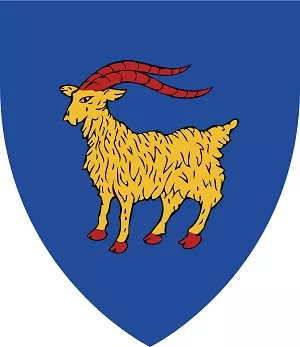
Croatian Parliament - ZAKON O GRBU, ZASTAVI I HIMNI RH TE ZASTAVI I LENTI PREDSJEDNIKA RH which based its decision on the design by Miroslav Šutej F.C.A. proposals.MaGa (based on Decision of the Parliament) - Converted to vector by Offnfopt, Public domain, via Wikimedia Commons
Istria – featuring a shield of Azure, depicting a golden goat (buck goat) with red hooves and horns, set against a dark blue background. The goat has been claimed as a symbol of Istria since ancient times. However, the origins of this coat of arms remain unclear, and prior to the 19th century, Istria had no official symbol. The earliest depictions can be found on the maps of Johann Weikhard von Valvasor in the 17th century and later in Pavao Ritter Vitezović's Stemmatographia sive armorum Illyricorum delineatio, descriptio et restitutio (1701). It wasn't until 1861, when Istria became a Crown land in the Austrian Empire, that this coat of arms gained official status. Traditional representations of the arms varied greatly depending on the author, with differences in background color, the color and position of the goat's hooves and horns, the goat's stance (sometimes passant or statant), its orientation (facing right or left), and even the gender of the goat depicted. The current variant used in the crest and as the coat of arms of the County of Istria is derived from the arms established in 1861 by Hugo Gerard Ströhl for the March of Istria.
Coat of arms of Slavonia
Slavonia – featuring a shield of Bleu celeste, showcasing a fess Gules fimbriated Argent, adorned with a six-pointed golden star (morning star) above two silver stripes. Positioned above these elements is a running Pine marten in natural colors, set against a red field. This emblem symbolizes the rivers Drava and Sava, which delineate the Northern and Southern borders of Slavonia, respectively. The historically accurate version of the arms utilizes a heraldic blue rather than a lighter shade. This coat of arms traces its origins to an earlier version found on Slavonian Banovac coins minted between 1235 and 1384, depicting a marten running between two six-pointed stars. Officially granted by King Vladislaus II Jagiellon on December 8, 1496, it served as the official seal of the Croatian Sabor from 1497 until the late 18th century.
History of the Flag of Croatia
The flag of Croatia intricately weaves together the historical narrative of the region, embodying a rich tapestry of cultural heritage. Its design, featuring a tricolor of red, white, and blue, draws inspiration from the flags of the Kingdoms of Croatia, Slavonia, and Dalmatia. This amalgamation of colors serves as a visual representation of the unity and diversity inherent in Croatian identity, reflecting the shared history and aspirations of its people.
Dating back to 1848, the red-white-blue tricolor has stood as a steadfast symbol of Croatian nationalism. Its adoption during the era of romantic nationalism echoed sentiments of solidarity and independence, resonating with similar movements across Europe. Throughout periods of political upheaval and transformation, this tricolor remained a resilient emblem of Croatian pride and resilience.
During the Kingdom of Yugoslavia, the Croatian flag underwent subtle variations reflective of shifting political dynamics. While retaining the familiar tricolor, it lacked the modern crown above the chequy, distinguishing it from its contemporary counterpart. However, with the advent of World War II and the establishment of the Independent State of Croatia, the flag underwent significant alterations, incorporating ideological symbols reflective of the ruling regime.
In the aftermath of World War II, Croatia became a constituent republic within the Socialist Federal Republic of Yugoslavia. The flag, imbued with communist symbolism, featured the chequy alongside motifs representing agriculture and industry. Yet, as the tides of change swept across Eastern Europe in the late 1980s, Croatia embarked on a journey of political and cultural rejuvenation.
Amidst the transition to multiparty democracy, the Croatian flag underwent a symbolic transformation. Shedding the vestiges of communist ideology, the chequy emerged as a standalone symbol, reclaiming its historical significance as a timeless emblem of Croatian heritage. The red and white variants of the chequy, each carrying its own historical significance, became prominent features of the evolving flag.
In the lead-up to Croatia's declaration of independence in the early 1990s, the flag witnessed further refinements. The introduction of a coat of arms, featuring the iconic checkerboard pattern, marked a pivotal moment in Croatian history. This coat of arms, officially adopted in December 1990, encapsulated the nation's aspirations for sovereignty and self-determination.
Today, the Croatian flag stands as a powerful symbol of unity, resilience, and national pride. Its vibrant colors and distinctive design serve as a beacon of hope and inspiration for generations of Croatians, embodying the enduring spirit of a nation forged through centuries of struggle and triumph.
Curiosities and Questions about the Croatia Flag
Who designed the Flag of Croatia?
The Flag of Croatia was designed by Miroslav Šutej, a prominent Croatian avant-garde painter and graphic artist. Born in Duga Resa in 1936, Šutej studied painting at the Academy of Fine Arts Zagreb under Krsto Hegedušić. He later became a professor at the Academy and was recognized as a full member of the Croatian Academy of Sciences and Arts in 1997. In addition to designing the Croatian flag, Šutej's creative talents extended to crafting banknotes for the Croatian kuna, the Croatian coat of arms, and the jersey pattern of Croatia's national football team.
Croatia Flag 175th Anniversary
In 2023, Croatia celebrated the 175th anniversary of its national flag, a powerful emblem of unity and identity. Originating in 1848, the tricolor design symbolizes Croatian statehood and historical legacy. Crafted by Ban Josip Jelačić, the flag's unique blend of red, white, and blue reflects unity among Croatia's historical provinces. Despite facing challenges over the years, the flag remains deeply rooted in Croatian culture. Its significance was reaffirmed in 1990 during Croatia's transition to democracy. ( Read Morea)
Why Does Belichick Have a Croatia Flag?
Bill Belichick proudly displayed the Croatian flag on his attire during a New England Patriots game, part of the NFL's initiative allowing players and coaches to wear patches representing their cultural heritage. He is of Croatian ancestry; his paternal grandparents, Marija Barković and Ivan Biličić, emigrated from Draganić in 1897 and settled in Monessen, Pennsylvania, having changed their names to Mary and John Belichick at the suggestion of immigration officers. While not a citizen of Croatia, Belichick explained that his Croatian ancestry, stemming from his father, holds significant meaning for him. His mother was of English descent, thus representing half of his family heritage. Belichick expressed pride in showcasing his Croatian roots and noted the positive reception he received from individuals across the ocean.
Flag Controversy in Croatia during the 1998 World Cup
During Croatia's unexpected success in the 1998 World Cup, attention turned to the country's flag, sparking controversy. An article in the London Evening Standard criticized Croatia, calling it "one of the nastiest little nations in Europe" and accusing its government of racism. The article's interpretation of the flag, linking it to Croatia's fascist past, drew backlash from Croatian officials. They emphasized the flag's ancient origins dating back to the ninth century, highlighting its enduring significance despite past associations. ( Read More)
How to Draw the Croatia Flag?
No words can match the clarity of a video, enjoy it!


